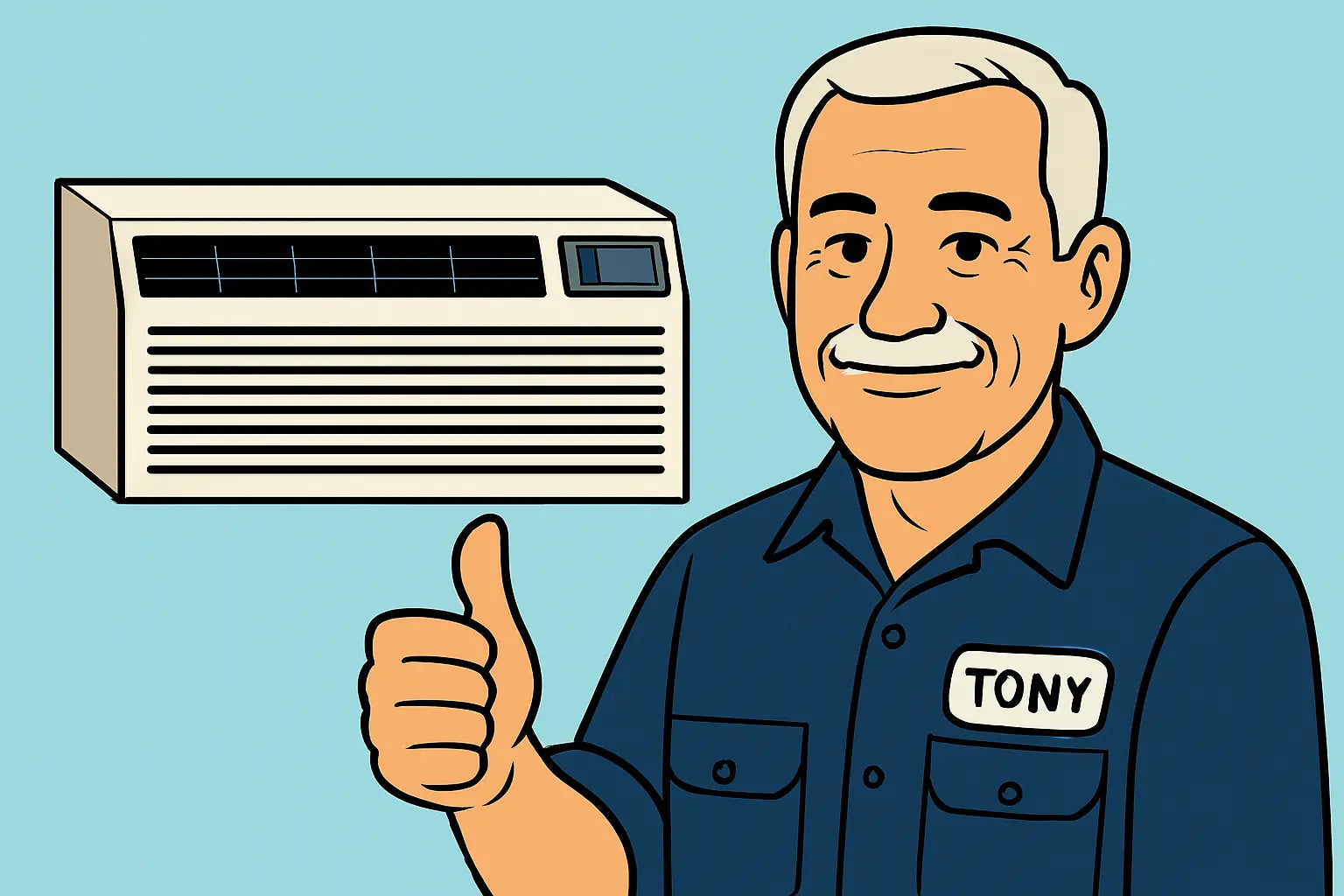Intro from Tony
Hey folks, Tony checking in. You’ve got your Amana Distinctions 12,000 BTU PTAC with 3.5 kW electric heat, but are you really getting the most out of it? If your unit leaks, creates puddles, or struggles to maintain airflow, your wall sleeve angle or drainage setup might be the culprit.
I’m going to show you why sleeve tilt matters, how to optimize drainage, and practical steps to avoid indoor water issues. Follow along, and your PTAC will run quietly, efficiently, and drip-free. 🛠️💧
1. Why Sleeve Tilt and Drainage Matter
A PTAC unit works by moving air and removing humidity from a room. Improper sleeve tilt can lead to:
-
Water pooling inside
-
Reduced cooling efficiency
-
Mold growth around the unit
-
Premature component wear
A small adjustment can make a huge difference. Think of it like tilting a slightly crooked cup—the liquid flows where it should instead of spilling all over your floor.
For a technical overview of PTAC operation and the importance of drainage, check out Energy Star’s PTAC guide.
2. Tools and Materials Needed
Before you start, gather:
-
Level (torpedo or laser)
-
Shims or adjustable wedges
-
Screwdriver or drill
-
Silicone or weather-resistant sealant
-
Small container or bucket for water test
-
Gloves and safety goggles
3. Checking and Adjusting Sleeve Tilt
3.1 Inspect the Current Sleeve
-
Remove the PTAC unit from the sleeve.
-
Use a level to check side-to-side and front-to-back tilt.
-
The recommended tilt is slightly downward toward the outside, usually about 1/4 inch per foot.
3.2 Adjust as Needed
-
Add shims under the sleeve or adjust mounting brackets.
-
Double-check the level after every tweak.
3.3 Seal the Sleeve
Once level, apply weather-resistant sealant around sleeve edges to prevent air and water infiltration.
For more detailed installation tips, refer to Amana’s installation guide.
4. Ensuring Proper Drainage
4.1 Check Condensate Drain
-
Most Amana Distinctions PTACs have a built-in condensate path leading outside.
-
Look for blockages or mineral buildup.
-
Flush with water or mild bleach solution to ensure flow.
4.2 Water Test
-
Pour a small amount of water into the unit’s pan.
-
Observe if it flows out smoothly.
-
Adjust tilt if water pools instead of draining.
For more on AC water drainage, see Bob Vila’s AC maintenance guide.
5. Common Mistakes to Avoid
-
Zero or negative tilt: Water will back up indoors.
-
Over-tilt: Unit may pull in outside air or reduce efficiency.
-
Ignoring debris in sleeve: Leaves, dust, and insects can block drains.
-
Skipping sealant: Air leaks reduce efficiency and can lead to mold.
6. Step-by-Step Fix for Leaks
-
Turn off the PTAC and unplug it.
-
Remove the front panel and inspect the condensate pan.
-
Clear any debris in the drain.
-
Adjust sleeve tilt with shims to a slight outward angle.
-
Apply weather-resistant sealant around sleeve edges.
-
Reinstall PTAC and run a test in cooling mode.
-
Verify water drains outside and airflow is unobstructed.
7. Pro Tips from Tony
-
Regularly inspect your sleeve and drain during monthly filter cleaning.
-
Keep vegetation, leaves, and debris away from the exterior of the sleeve.
-
If water is still pooling, check for ice formation on the evaporator coil, which can block drains.
For advanced troubleshooting of leaks and water issues, see HVAC Senior PTAC tips.
8. Preventive Maintenance
-
Clean the condensate drain every 3–6 months.
-
Check sleeve tilt annually, especially after seasonal shifts or building settling.
-
Inspect and clean filters and coils to reduce water buildup.
Regular maintenance keeps your unit efficient and prolongs lifespan, saving on repairs. More tips can be found at HD Supply PTAC maintenance.
9. Troubleshooting Quick Reference
| Problem | Likely Cause | DIY Fix | Call Pro If… |
|---|---|---|---|
| Water pooling indoors | Sleeve tilt wrong | Adjust tilt, check drain | Persistent leaks |
| Slow drainage | Blocked pan or drain | Flush with mild solution | Water still standing |
| Reduced cooling | Airflow blocked | Clean filters, check sleeve | No improvement |
| Noise from water movement | Loose pan or tilt | Re-secure pan/shims | Loud scraping or buzzing |
Final Thoughts from Tony
And that’s the Tony-approved guide to optimizing sleeve tilt and drainage for the Amana Distinctions 12,000 BTU PTAC with 3.5 kW electric heat. A little attention here prevents leaks, mold, and inefficiency for years.
If you’re ready to check out the exact model I’m talking about, head over to The Furnace Outlet’s Amana Distinctions PTAC. Set it up right, keep the tilt correct, and enjoy smooth, drip-free comfort. 🍻
Need some maintenance tips? Visit my guide: Keep It Running Smooth.
See you later,
- Tony the Trusted Tech







